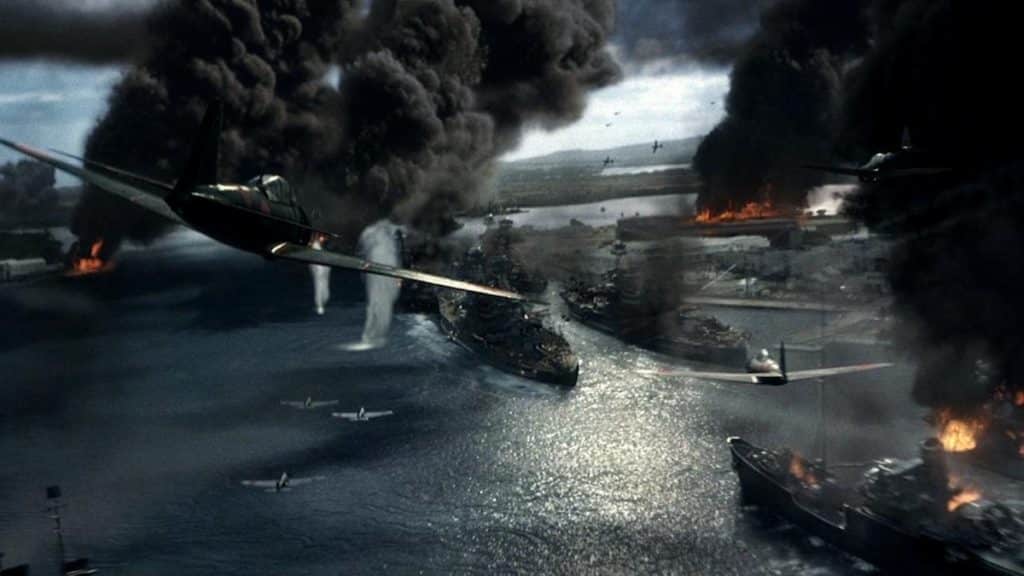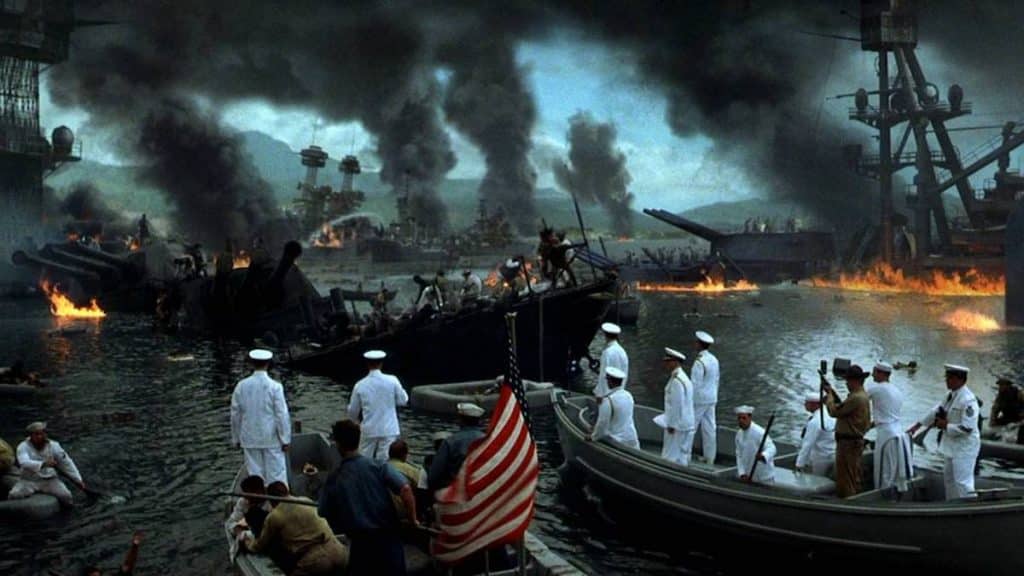With his 2001 epic, Michael Bay solidified himself as an all-American auteur, as well as the bombastic concept of Bayhem.
80 minutes into Michael Bay’s Pearl Harbor, the titular surprise attack finally arrives. It is, without a doubt, one of the most virtuosic action set pieces ever committed to the screen, a flawlessly orchestrated symphony of carnage that burns for close to 40 minutes. Everything that you could possibly hope for from a maximalist, hyperkinetic blockbuster spectacle is here. There’s fire cascading, plumes of black smoke rising, bullets and bombs raining down, planes tumbling from the skies, boats being torn asunder, and bodies being flung about like ragdolls. Annihilation and national tragedy have never looked so stunning or—and it feels gross saying this—felt so exhilarating.
Back in 2001, Pearl Harbor was released to box office success and critical disdain. Audiences didn’t yet have a word to adequately describe the face-melting images that they were witnessing. It was a combination of the scope, the constant motion, the frenzied editing, and the deft combination of practical and special effects. We have a word for it all now, though, that, like “Hitchcockian” or “Kubrickian,” codifies the hallmarks of a towering, totemic auteur: “Bayhem.” From the release of Transformers in 2007 until the release of Transformers: Age of Extinction in 2014, the silver screen turned orange and teal. Bayhem’s lizard-brained bombast was, to the delight of some and the dismay of others, Hollywood’s era-defining aesthetic.
And that aesthetic was rarely more glorious (or more problematic) than in Pearl Harbor. It treats the deaths of thousands like an elaborate fireworks display. If the film were 70 minutes long and consists solely of the surprise attack sequence and the subsequent retaliatory Doolittle Raid, it’d probably be one of the greatest films of all time. It’d at least some sort of vulgar masterpiece, insensitive and inspired in equal measure. Alas, the film we actually got is a graceless behemoth that runs over three hours, crippled by its fidelity to grounded narrative and an absurd amount of love triangle nonsense.
The characters we’re meant to latch onto are so flavorless they barely register on the palate. The two salt-of-the-earth American fighter pilots (Ben Affleck and Josh Hartnett) and the nurse they both fall in love with (Kate Beckinsale) are as milquetoast as they come. By the end, you’re almost begging for an injection of crassness. Then Mark Wahlberg shows up out of nowhere and starts chugging Bud Light. Anything to remind us that personality is a thing that exists.

Why make us sit through so much protracted melodrama? Why not just let us get straight to the chunky good stuff? Watching Pearl Harbor again, what’s striking is just how transparently calculated it is. It so shamelessly attempts to construct the impression of a respectable historical epic, the kind of event movie that lands you a Titanic-sized haul of statuettes. Indeed, it ended up becoming the first film ever to win an Academy Award while also being nominated for Worst Picture at the Razzies.
Prestige is something that you have to own. Pearl Harbor wears its prestige like a shoddy Halloween costume, copying the gestures without ever having the conviction necessary to really sell the gravity of its subject matter. As such, it has such unintentionally hilarious moments like when Franklin D. Roosevelt (Jon Voight) goes full Dr. Strangelove, hoisting himself from his wheelchair to deliver a corny message about redefining the impossible. It’s the only film in Bay’s oeuvre that feels insincere, chafing against his impulses.
That isn’t to say that it isn’t instantly identifiable as a Michael Bay film. His fingerprints are still all over his work here, even as the innate banality of the material proves resistant to his touch. Even the sappy flashback sequence at the beginning of the film, showing the Affleck and Hartnett characters playing together as children, is unmistakably Bay. (The huge low-angle shot of a biplane in flight should be a dead giveaway.) Equally unmistakable are the glossy romantic sequences, which have the look and emotional weight of a perfume commercial.
These calling cards brim with Bay’s DNA to the point it could’ve been titled Michael Bay’s Pearl Harbor. And while these visuals definitely fail to evoke much actual feeling, what they do evoke is a sense of nostalgia for when actual craftsmen with actual visions spearheaded Hollywood blockbusters. Bay’s mainstream presence has dwindled in recent years as the Disney overlords continue to seize and consolidate the territory that once belonged to him, instead opting for homogeneous superhero sludge. Bay’s colorful, dazzlingly unhinged brand of destruction simply isn’t in vogue anymore. It’s been usurped by anonymous, algorithmic, committee-generated visual vomit.

If it seems strange to you that Bay’s displacement from the apex of the cultural pyramid is worth lamenting, consider this. The suits in charge of the world’s most powerful media megacorporation apparently only just discovered that it’s possible to film a sunset without a green screen. People who hate movies are making the only movies that seem to matter anymore, with million-dollar action sequences handed to visionless hack directors who hate action. Nothing could be bleaker.
Bay, in contrast, loves action. He loves the intricacies involved in setting up, operating, and then incinerating a thousand different moving parts. After all, we’re talking about a perfect technician whose entire aesthetic philosophy can be traced back to an idea he had when he was a child to blow up his toy train set and shoot the result with an 8mm camera. Inflate the budget to a few hundred million, enlarge the format, and preserve that eye for scorching pageantry, and what you get are astonishing compositions that nobody other than Michael Bay could conceive of or conjure.
Such is the bravura tracking shot in Pearl Harbor that trails a Japanese bomb as it spirals ominously downwards towards the USS Arizona. Or the shot of Cuba Gooding Jr. gunning down a Japanese fighter. Or the shots of Affleck and Hartnett entangled in a frantic dogfight. Or the shot of a torpedo cleaving a battleship in two. Or the underwater shot of sailors desperately trying to stay afloat as a bullet-ridden American flag sinks beneath them. The list goes on. These are those all too rare, increasingly precious images that make you feel like a criminal if you’re not watching them projected onto the biggest screen imaginable.
Of course, for all its possibilities, Bayhem has its limitations. Nowhere are those limitations more obvious than in Pearl Harbor, whose dizzying peaks are neutered by its abyssal troughs. The accusation that’s always been leveled against Bay is that his style is too bludgeoning and inelastic for sustained storytelling, effective in the form of his commercials (for which he’s won multiple Clio Awards), but fatiguing when stretched to feature-length. It’s all sensation, all idealization, all the time. The non-stop shiny dynamism can become suffocating.
These are those all too rare, increasingly precious images that make you feel like a criminal if you’re not watching them projected onto the biggest screen imaginable.
That accusation holds water, for sure, but Bay’s inflexibility doesn’t necessarily have to be a problem. In a project like Pain & Gain, which begins in the gutter and never even attempts to leave, Bay’s single-minded aesthetic purity is utterly irresistible. Every frame is designed to be as lurid and grotesque as possible, indulging in the moral decay and delicious downfall of irredeemably reprehensible individuals.
Regrettably, Pearl Harbor isn’t Pain & Gain. Pearl Harbor is a classic, swirling Hollywood romance, something that Bay, whose sensibilities probably lie closer to pornography than anything else, is totally unqualified and unequipped to execute convincingly. What a film like Pearl Harbor really demands (on top of a much better script, obviously) is a filmmaker with very different qualities. It needs a mature eye for character detail, the patience to flesh out inner lives, and the instinct to mark the sparrow’s fall. In a word, it demands empathy. Bay is an empathy vacuum, a juvenile, raging misanthrope.
That’s why, even in Pearl Harbor, he still has so many people saying funny lines just before they get blown up. That’s why it’s so puzzling that he was ever drawn to the material in the first place. Still, weirdly enough, Pearl Harbor might just be the best thing that ever happened to Bay. It crystallized his strengths and weaknesses and gave him the build-up of hatred necessary to follow up with the purgative, paroxysmal Bad Boys II—a film of unmitigated depravity, a plunge into the odious American id, and a stone-cold masterpiece. For that, we should be eternally grateful.